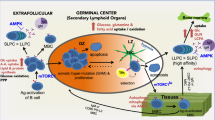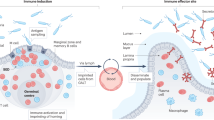Abstract
To sustain the bio-energetic demands of growth, proliferation, and effector functions, the metabolism of immune cells changes dramatically in response to immunologic stimuli. In this review, I focus on B cell metabolism, especially regarding the production of intestinal IgA antibody. Accumulating evidence has implicated not only host-derived factors (e.g., cytokines) but also gut environmental factors, including the possible involvement of commensal bacteria and diet, in the control of B cell metabolism during intestinal IgA antibody production. These findings yield new insights into the regulation of immunosurveillance and homeostasis in the gut.


Similar content being viewed by others
References
Pearce EL, Pearce EJ (2013) Metabolic pathways in immune cell activation and quiescence. Immunity 38:633–643
Mathis D, Shoelson SE (2011) Immunometabolism: an emerging frontier. Nat Rev Immunol 11:81
Buck MD, O’Sullivan D, Pearce EL (2015) T cell metabolism drives immunity. J Exp Med 212:1345–1360
O’Neill LA, Pearce EJ (2015) Immunometabolism governs dendritic cell and macrophage function. J Exp Med 213:15–23
Aronov M, Tirosh B (2016) Metabolic control of plasma cell differentiation- what we know and what we don’t know. J Clin Immunol 36(Suppl 1):12–17
Chang CH, Pearce EL (2016) Emerging concepts of T cell metabolism as a target of immunotherapy. Nat Immunol 17:364–368
Mockler MB, Conroy MJ, Lysaght J (2014) Targeting T cell immunometabolism for cancer immunotherapy; understanding the impact of the tumor microenvironment. Front Oncol 4:107
MacIver NJ, Michalek RD, Rathmell JC (2013) Metabolic regulation of T lymphocytes. Annu Rev Immunol 31:259–283
Delgoffe GM, Powell JD (2015) Sugar, fat, and protein: new insights into what T cells crave. Curr Opin Immunol 33:49–54
Frauwirth KA et al (2002) The CD28 signaling pathway regulates glucose metabolism. Immunity 16:769–777
Michalek RD et al (2011) Cutting edge: distinct glycolytic and lipid oxidative metabolic programs are essential for effector and regulatory CD4+ T cell subsets. J Immunol 186:3299–3303
Ray JP et al (2015) The Interleukin-2-mTORc1 kinase axis defines the signaling, differentiation, and metabolism of T helper 1 and follicular B helper T cells. Immunity 43:690–702
Porta C, Riboldi E, Ippolito A, Sica A (2015) Molecular and epigenetic basis of macrophage polarized activation. Semin Immunol 27:237–248
Jha AK et al (2015) Network integration of parallel metabolic and transcriptional data reveals metabolic modules that regulate macrophage polarization. Immunity 42:419–430
Doughty CA et al (2006) Antigen receptor-mediated changes in glucose metabolism in B lymphocytes: role of phosphatidylinositol 3-kinase signaling in the glycolytic control of growth. Blood 107:4458–4465
Dufort FJ et al (2007) Cutting edge: IL-4-mediated protection of primary B lymphocytes from apoptosis via Stat6-dependent regulation of glycolytic metabolism. J Immunol 179:4953–4957
Caro-Maldonado A et al (2014) Metabolic reprogramming is required for antibody production that is suppressed in anergic but exaggerated in chronically BAFF-exposed B cells. J Immunol 192:3626–3636
Gutzeit C, Magri G, Cerutti A (2014) Intestinal IgA production and its role in host-microbe interaction. Immunol Rev 260:76–85
Brandtzaeg P (2010) Function of mucosa-associated lymphoid tissue in antibody formation. Immunol Investig 39:303–355
Macpherson AJ, Koller Y, McCoy KD (2015) The bilateral responsiveness between intestinal microbes and IgA. Trends Immunol 36:460–470
Kunisawa J, Kurashima Y, Kiyono H (2012) Gut-associated lymphoid tissues for the development of oral vaccines. Adv Drug Deliv Rev 64:523–530
Ohno H (2016) Intestinal M cells. J Biochem 159:151–160
Bekiaris V, Persson EK, Agace WW (2014) Intestinal dendritic cells in the regulation of mucosal immunity. Immunol Rev 260:86–101
Gohda M et al (2008) Sphingosine 1-phosphate regulates the egress of IgA plasmablasts from Peyer’s patches for intestinal IgA responses. J Immunol 180:5335–5343
Mora JR et al (2006) Generation of gut-homing IgA-secreting B cells by intestinal dendritic cells. Science 314:1157–1160
Fagarasan S, Kawamoto S, Kanagawa O, Suzuki K (2010) Adaptive immune regulation in the gut: T cell-dependent and T cell-independent IgA synthesis. Annu Rev Immunol 28:243–273
Kunisawa J et al (2007) Sphingosine 1-phosphate regulates peritoneal B-cell trafficking for subsequent intestinal IgA production. Blood 109:3749–3756
Tsuji M et al (2008) Requirement for lymphoid tissue-inducer cells in isolated follicle formation and T cell-independent immunoglobulin A generation in the gut. Immunity 29:261–271
Kunisawa J et al (2015) Mode of bioenergetic metabolism during B cell differentiation in the intestine determines the distinct requirement for vitamin B1. Cell Rep 13:122–131
Patke A, Mecklenbrauker I, Erdjument-Bromage H, Tempst P, Tarakhovsky A (2006) BAFF controls B cell metabolic fitness through a PKC beta- and Akt-dependent mechanism. J Exp Med 203:2551–2562
Otipoby KL et al (2008) BAFF activates Akt and Erk through BAFF-R in an IKK1-dependent manner in primary mouse B cells. Proc Natl Acad Sci USA 105:12435–12438
Woodland RT et al (2008) Multiple signaling pathways promote B lymphocyte stimulator dependent B-cell growth and survival. Blood 111:750–760
Vander Heiden MG et al (2011) Metabolic pathway alterations that support cell proliferation. Cold Spring Harb Symp Quant Biol 76:325–334
Dufort FJ et al (2014) Glucose-dependent de novo lipogenesis in B lymphocytes: a requirement for atp-citrate lyase in lipopolysaccharide-induced differentiation. J Biol Chem 289:7011–7024
Pollizzi KN, Powell JD (2014) Integrating canonical and metabolic signalling programmes in the regulation of T cell responses. Nat Rev Immunol 14:435–446
Liu C, Chapman NM, Karmaus PW, Zeng H, Chi H (2015) mTOR and metabolic regulation of conventional and regulatory T cells. J Leukoc Biol 97:837–847
Kopf H, de la Rosa GM, Howard OM, Chen X (2007) Rapamycin inhibits differentiation of Th17 cells and promotes generation of FoxP3+ T regulatory cells. Int Immunopharmacol 7:1819–1824
Delgoffe GM et al (2009) The mTOR kinase differentially regulates effector and regulatory T cell lineage commitment. Immunity 30:832–844
Delgoffe GM et al (2011) The kinase mTOR regulates the differentiation of helper T cells through the selective activation of signaling by mTORC1 and mTORC2. Nat Immunol 12:295–303
Zhang S et al (2013) B cell-specific deficiencies in mTOR limit humoral immune responses. J Immunol 191:1692–1703
Benhamron S, Pattanayak SP, Berger M, Tirosh B (2015) mTOR activation promotes plasma cell differentiation and bypasses XBP-1 for immunoglobulin secretion. Mol Cell Biol 35:153–166
Lamichhane A, Kiyono H, Kunisawa J (2013) Nutritional components regulate the gut immune system and its association with intestinal immune disease development. J Gastroenterol Hepatol 28(Suppl 4):18–24
Kunisawa J, Kiyono H (2016) Sphingolipids and epoxidized lipid metabolites in the control of gut immunosurveillance and allergy. Front Nutr 3:3
Kunisawa J, Kiyono H (2015) Vitamins mediate immunological homeostasis and diseases at the surface of the body. Endocr Metab Immune Disord Drug Targets 15:25–30
Kunisawa J, Kiyono H (2013) Vitamin-mediated regulation of intestinal immunity. Front Immunol 4:189
Frank RA, Leeper FJ, Luisi BF (2007) Structure, mechanism and catalytic duality of thiamine-dependent enzymes. Cell Mol Life Sci 64:892–905
Webb ME, Marquet A, Mendel RR, Rebeille F, Smith AG (2007) Elucidating biosynthetic pathways for vitamins and cofactors. Nat Prod Rep 24:988–1008
Kunisawa J, Nochi T, Kiyono H (2008) Immunological commonalities and distinctions between airway and digestive immunity. Trends Immunol 29:505–513
Randall TD (2010) Bronchus-associated lymphoid tissue (BALT) structure and function. Adv Immunol 107:187–241
Weinstein PD, Cebra JJ (1991) The preference for switching to IgA expression by Peyer’s patch germinal center B cells is likely due to the intrinsic influence of their microenvironment. J Immunol 147:4126–4135
Kunisawa J et al (2013) Microbe-dependent CD11b+ IgA+ plasma cells mediate robust early-phase intestinal IgA responses in mice. Nat Commun 4:1772
Galli C, Calder PC (2009) Effects of fat and fatty acid intake on inflammatory and immune responses: a critical review. Ann Nutr Metab 55:123–139
Margioris AN (2009) Fatty acids and postprandial inflammation. Curr Opin Clin Nutr Metab Care 12:129–137
Arita M (2012) Mediator lipidomics in acute inflammation and resolution. J Biochem 152:313–319
Jin C, Flavell RA (2013) Innate sensors of pathogen and stress: linking inflammation to obesity. J Allergy Clin Immunol 132:287–294
Kunisawa J et al (2014) Regulation of intestinal IgA responses by dietary palmitic acid and its metabolism. J Immunol 193:1666–1671
Acknowledgements
The author’s work featured in this review article was supported by grants from MEXT/JSPS KAKENHI Grant Numbers 26293111, 16H01373, and 15H05790; from The Ministry of Health, Labour and Welfare (MHLW) and the Research on Development of New Drugs, the Japan Agency for Medical Research and Development (AMED); the Science and Technology Research Promotion Program for Agriculture, Forestry, Fisheries, and Food Industry; Astellas Foundation for Research on Metabolic Disorders, Terumo Foundation for Life Sciences and Arts and Suzuken Memorial Foundation.
Author information
Authors and Affiliations
Corresponding author
Rights and permissions
About this article
Cite this article
Kunisawa, J. Metabolic changes during B cell differentiation for the production of intestinal IgA antibody. Cell. Mol. Life Sci. 74, 1503–1509 (2017). https://doi.org/10.1007/s00018-016-2414-8
Received:
Revised:
Accepted:
Published:
Issue Date:
DOI: https://doi.org/10.1007/s00018-016-2414-8




